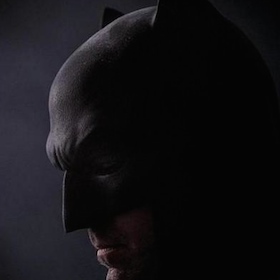Celebrating 75 Years Of Batman
On March 30, Batman turned 75. This year, DC Comics has devoted itself fully to promoting and celebrating his birthday, releasing new series titles, tons of variant covers, crossovers, new merchandise, and hosting conference panels at San Diego Comic Con. As any comic book fan knows, this means taking an already oversaturated, overexposed character and dialing it up to eleven (also known as The Wolverine Method) to the point where the news had no choice but to declare Wednesday July 23rd as “Batman Day.” As insane as all this is, it’s really kind of impressive. If you stand back from the insanity of it all, you come to the realization, truly, that Batman isn’t just a character anymore but an icon around the world.
My first memory of Batman is from 1992’s Batman: The Animated Series by Bruce Timm and Paul Dini. The opening credits featured a silent Batman theatrically bringing down a pair of noirish bank robbers. He stalked from the shadows, flipped and punched and threw a batarang. He disappeared before the cops arrived leaving the bad guys tied up as a gift. Storm clouds broke, thunder struck like a hammer and lightning scarred the sky, revealing Batman standing vigilantly, if only for a second in that sudden blade of light, and the screen cut to black before the episode title card. What’s striking is that there was no actual title within the credits, no chanting choir repeatedly saying his name, no sign declaring Batman: The Animated Series, but you knew who it was. You knew by the way he moved, the costume he wore, the symbol on his chest. You knew. And that’s what Batman is. Infinitely recognizable.
Over 75 years, few characters have been through as many permutations, yet none feel inherently wrong (though Joel Shumacher certainly gave it a good effort). There were the early years, the pulp detective; then came the sci-fi adventures in the 50s, the lighthearted camp of the sixties, followed by the Adam West series in the 70s. Denny O’Neil took over the comics in the mid part of that decade and dialed it all back. He, Steve Englehart, Neal Adams and Julie Schwartz said, “Make him dark,” and Batman became psychologically damaged, a noirish character again. In the 80s came Tim Burton and Frank Miller. More recent years have seen Chistopher Nolan, Grant Morrison, Scott Snyder and Peter J. Tomasi sign their names to the character with stark and sometimes contradictory versions. Yet, they’re all instantly recognizable as one aspect of the same man.
At this moment in his history, Batman has never been more visible. He outsells every other comic title. His movies have grossed over two billion dollars. He’s had more TV shows than any comic character, and there more non-fiction books written about him than there are for Abraham Lincoln. One could blame the Internet and social media for this enhanced exposure because everything is heightened here, but the fact is, there’s something about the character, some sliver that has remained unchanged throughout every incarnation that keeps people invested. Those critical of superheroes immediately point their fingers and declare it as dumb wish fulfillment. Well, all fiction is wish fulfillment, and having idealized men and women in comics may be wish fulfillment, but what’s wrong with that? We react to fiction because we need a break in reality, though it’s the (somewhat) realistic trait of Batman’s that we all identify with or wish we had — the strength to carry on.
Batman has no powers. He has money and intelligence, and he takes the tragedy of his life and turns it into a crusade. Driven by loss, he devotes himself to trying to keep the pain he suffered from happening to others. There’s a layer of sacrifice here, and also Greek tragedy. He’s aware enough to know his great work will never be complete — there will always be crime and death and violence — and despite this he’s still wrecking his body to save the few people he can, sacrificing his own happiness for the lives of strangers. Over the years, he’s given up the chance at happiness with Julie Madison, Andrea Beaumont, Silver St. Cloud, Selina Kyle, and countless others because of this obsession. In turn, he has taken on youths with tragic backstories as wards in the hope of not just creating a legacy to continue after he’s gone, but primarily because he wanted them to have enriching lives—and to specifically make sure that even if they became superheroes as well, they wouldn’t necessarily become him. He wants to save them from that life.
Batman debuted in "Detective Comics 27" in 1939, and followed the next year with his partner, Robin the Boy Wonder. Robin was the first of the sidekicks, and many titles across a number of companies followed this pattern over the next fifteen years. Some were good (Kid Flash) others were terrible (Speedy), but what struck kids particularly was the oddball pairing of the ominous and blue-black Batman and his androgynous, brightly colored Robin. Young readers liked Robin because they identified with him and felt like they could be a part of these grand adventures. All those kids who were losing their fathers in the war found a measure of solace in this young orphan trading tragedy for high adventure. They empathized with Dick Grayson, they appreciated the father/son dynamic of Bruce and Dick, getting a form of parenting and guidance from the comics, and hope most of all.
On a baser level, one certainly less depressing, Batman is simply cool. Who doesn’t want to have the body of a young god, the mind of a genius, James Bond’s gadgets, and the money of an oil baron? Who doesn’t want to be able to say, “I came from this awful thing and turned it into something great”? In his own way Batman’s an inspirational figure — Batman can come back from anything and return new and better and stronger for it.
Nowadays, things are hard all around. Living in the shadow of 9/11 and economic collapse, renewed paranoia from incompetent or overreaching government and sensationalist news, we’re living in a frightening world. Batman is a reflection of his own dark world, thereby making him a reflection of ours. He’s taken on the worst the world can give him and made it part of his appearance, part of his life; he reflects all the bad things in the world and uses it to fight off those bad things.
Anti-heroes are particularly popular now, and Batman always seems to be at the top of the anti-hero list. The costume sure helps in that regard. Stand Batman and Lex Luthor beside each other; or Batman and Superman; or Batman and Spider-man; or Batman and Wolverine. Now, who looks like the bad guy in those shots? Probably the guy that looks like a Renaissance painting of hell. But that’s the thing — he’s a good guy! He looks like one of the bad guys but is actually a good guy! It’s something so basely childish, but it works on anyone from any age, gender or orientation. He’s a good guy who looks like a bad guy and sounds like an angry Kevin Conroy. There simply is nothing cooler than that.
Many people like to point out that it’s Bruce Wayne that’s the mask, and Batman the true personality. I always thought differently. To me, Bruce Wayne was the wellspring, the little boy that saw the evil of the world and created something to be a lightning rod for that evil; to take on the burden and the hardship for others so no one has to live through the same trauma he did. So, as a merely mortal, soft man, he takes on all forms of evil, sacrificing himself and his own happiness for the sake of others. There’s an empathy to this that many people forget among the graphic violence and psychotic clowns.
At the same time, you may disagree with my definition of Batman. However, neither one of us is wrong. And that’s one of the great things about Batman. He is whoever we personally define him to be. It’s that malleability that makes him as popular as he is.
GET THE FREE uINTERVIEW iPHONE APP FOR LATEST NEWS UPDATES
RELATED ARTICLES
Get the most-revealing celebrity conversations with the uInterview podcast!








Leave a comment